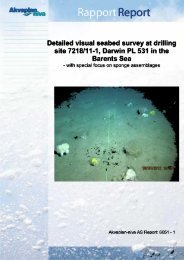A study of the priority substances of the Water Framework Directive ...
A study of the priority substances of the Water Framework Directive ...
A study of the priority substances of the Water Framework Directive ...
You also want an ePaper? Increase the reach of your titles
YUMPU automatically turns print PDFs into web optimized ePapers that Google loves.
..:::::::::: nickel and nickel compounds<br />
..:::58<br />
23 Nickel and nickel compounds<br />
� Nickel compounds are confirmed human carcinogens<br />
and allergens.<br />
� Nickel is widely used, and <strong>the</strong>re is significant<br />
air transport <strong>of</strong> nickel from Northwest Russia to<br />
Norway.<br />
� In general nickel concentrations in Norway<br />
are low.<br />
� No fur<strong>the</strong>r screening is regarded necessary.<br />
Production and use<br />
Nickel compounds have wide usage. They are<br />
present in fossil fuels. Globally, nickel has been<br />
important in <strong>the</strong> production <strong>of</strong> stainless steel<br />
and nickel alloys, electroplating, non-ferrous<br />
alloys, catalysts, pigments, component <strong>of</strong> Ni-Cd<br />
and NiMH batteries etc.<br />
Coinage contain up to 25% nickel. Nationally<br />
nickel metal is produced at Falconbridge in<br />
Kristiansand. According to SFT <strong>the</strong> annual<br />
turnover <strong>of</strong> nickel has increased from 2257 tons<br />
in 1990, via 4755 tons in 1998 to 3665 tons in<br />
2002.<br />
Most <strong>of</strong> <strong>the</strong> nickel is in form <strong>of</strong> alloys. Nickel in<br />
waste (from sandblasting sand, batteries and<br />
catalysers) has only dropped from 158,5 tons in<br />
1990, to 88,6 tons in 2002. The amount emitted<br />
from batteries has remained stable at 65<br />
tons.<br />
Emissions, discharges,<br />
distribution and hot-spots<br />
Nickel is emitted by natural (volcanoes, erosion)<br />
and anthropogenic sources. Norwegian emissions<br />
to air have been stable at 40 tons (fossil<br />
fuels, asphalt) since 1995. Emissions to soil have<br />
dropped from 33 tons in 1990 (mainly sandblasting<br />
sand, some fertilizer) to about one ton<br />
in 2002. The data on general discharges to<br />
water are scarce; but <strong>the</strong>re have been significant<br />
discharges from Falconbridge in Kristiansand in<br />
Vest-Agder County. Airborne long range transport<br />
<strong>of</strong> nickel by air is registered from<br />
Northwest Russia to Nor<strong>the</strong>rn Norway. The<br />
area around Falconbridge is considered a<br />
hotspot. This area is thoroughly investigated.<br />
A <strong>study</strong> <strong>of</strong> <strong>the</strong> <strong>priority</strong> <strong>substances</strong> <strong>of</strong> <strong>the</strong> <strong>Water</strong> <strong>Framework</strong> <strong>Directive</strong><br />
TA-2140/2005<br />
FACTS<br />
Cas no.: 7440-02-0<br />
Synonyms/compounds:<br />
Nickel acetate tetrahydrate: Ni(C 2 H 3 O 2 ) 2 .4H 2 O<br />
Nickel ortho-arsenate: Ni3 (AsO4 ) 2<br />
Nickel bromate hexahydrate: Ni(BrO3 ) 2 .6H2O Nickel carbonate: NiCO 3<br />
Nickel carbonate hydroxide: NiCO 3 .2Ni(OH) 2<br />
Nickel carbonyl: C 4 NiO 4<br />
Nickel chloride: NiCl 2<br />
Nickel fluoride: NiF2 Nickel hydroxide (hydrate): Ni(OH) 2 .H2O Nickel nitrate hexahydrate: Ni(NO 3 )2.6H 2 O<br />
Nickel oxide: NiO<br />
Nickel sulfate hexahydrate: NiSO 4 .6H 2 O<br />
Nickel subsulfide: Ni3S2 Properties: Silvery white metal<br />
Toxic effects: Nickel compounds are confirmed<br />
human carcinogens and may cause allergies<br />
(ClassLab, HSDB). LC50 for Daphnia magna is 0,5 mg<br />
nickel/litre (96 hour) and 4-20 mg/l for fish (WHO). For<br />
mammals <strong>the</strong> most toxic compound is nickel carbonyl.<br />
LC50 rat is 0,1 mg nickel carbonyl/litre air for a 20<br />
minute exposure.<br />
Log Kow: -<br />
Persistence: Nickel may exhibit a high mobility within<br />
<strong>the</strong> soil pr<strong>of</strong>ile, reaching ground and surface water<br />
and rivers and lakes. Acid rain can mobilize nickel<br />
from <strong>the</strong> soil. Nickel carbonyl may volatilize from<br />
water, o<strong>the</strong>r compounds will not. Nickel compounds<br />
accumulate in plants, and have low to moderate<br />
potential for bioconcentration in aquatic organisms.<br />
<strong>Water</strong> solubility: Insoluble (some compounds are soluble).<br />
Molecular formula: Pure metal: Ni<br />
Metabolites: -<br />
Monitoring<br />
Nickel and nickel compounds have been monitored<br />
RID, a time trend exists here. O<strong>the</strong>r studies<br />
are included in <strong>the</strong> references.

















